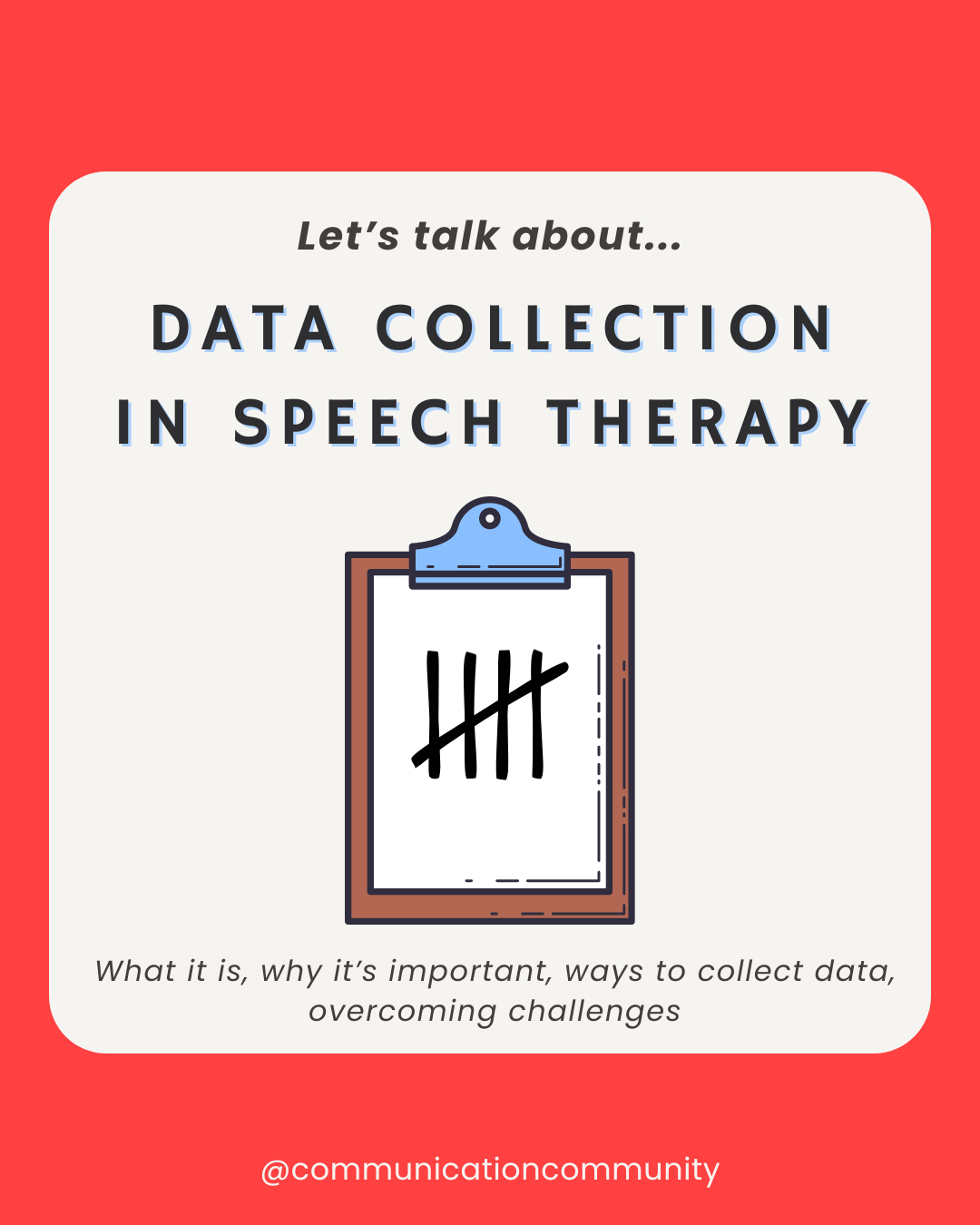As a speech-language pathologist (SLP), you know that taking data is critical. You also know that taking valid and reliable data can be tricky, especially when you have a group session, especially when you’re sitting on the floor playing with a client, especially when you’re trying to observe a complete swallow, especially when…you get the point!
Though data collection is challenging (yet necessary), it can be helpful to remember why it’s important, as well as explore different ways to collect data. Read about what data collection is, why it’s important, methods for collecting data, overcoming challenges, and our tips below.
What is Data Collection?
In speech therapy sessions, data collection includes both objective and subjective data. When people think of data, they often think about objective, or quantitative, data primarily, but subjective data is important for telling the client’s whole story. Objective and subjective data may be collected during assessments and treatment sessions and may be analyzed after treatment (e.g., when the SLP is writing a progress report).
Objective Data in Speech Therapy
Objective data in speech therapy refers to the quantitative data that is collected in sessions.
Quantitative Data: This may include information such as the overall accuracy of a certain skill or the number of times a skill was observed. The SLP may note that a client produced the /s/ sound correctly in 18/20 trials, or with 90% accuracy.
Types of objective/quantitative data can include:
- Frequency
- Rate
- Percentage
- Latency (i.e., time between stimulus presented and response)
- Duration
- Rubrics (i.e., demonstrate 3 out of 4 skills)
- Response independence (i.e., with or without cues)
Subjective Data in Speech Therapy
Subjective data in speech therapy refers to the qualitative and anecdotal observations that may occur in sessions.
Qualitative Data: This may include descriptive data (e.g., responses to: Did the client appear tired during the session? Were they more easily distracted? Were they really engaged?) and information that doesn’t necessarily have a *number* attached to it. For example, if the client’s accuracy on a skill was lower than the previous week’s, you may note that they reported feeling tired in that session, which may explain why their accuracy was diminished.
Prompts and Cues: Prompting and cueing are generally considered types of subjective data, although they can be quantified in some instances. Different settings may describe prompts and cues differently. For instance, some settings classify minimal, moderate, and maximal cueing based on how frequently the client was cued (e.g., in 0-25% of trials, 26-50% of trials, etc.). Other settings provide specific definitions for what constitutes a minimal, moderate, or maximal cue. It is important to describe the type of prompt and/or cue used, as well as its significance, in documentation.
Anecdotal Data: This may include information that helps you understand your client more holistically. For example, you may note that the client completed their carryover homework, which may indicate buy-in to services and in turn lead to a better prognosis. Interviews are also another method that can provide quality anecdotal data.
Types of qualitative data can include:
- Observations
- Client self-report
- Interviews
- Descriptive information about emotions, medical status, behaviors, etc.
- Prompts and cues used
Why Data Collection is Important in Speech Therapy
As therapists, we often hear that therapy should have a focus on connection with clients rather than data collection. This is very true! That being said, there are many instances where formal data gathering is necessary and also entirely unavoidable.
Data collection is important…
- For billing and legal reasons: Reporting specific data is often required for insurance and billing purposes as well as for Individualized Education Program (IEP) documentation. To receive reimbursement and account for services provided, documentation, which includes data collected, is imperative.
- For evidence-based practice: Collecting and analyzing data is an important component of evidence-based practice (EBP) in speech-language pathology. One component of EBP is internal evidence. Internal evidence involves collecting and analyzing subjective and objective information about the client you’re working with. This evidence can help you make informed decisions about their progress and future treatment plans. If your data shows that a client has met their goals, you can then determine if you should dismiss them from services or begin targeting new goals.
- For justification of services: Finally, data collection is important because it proves that the work you’re doing is necessary and effective. As a trained SLP, you may know internally that a client has benefited from speech therapy services. Still, without the data to back it up, other stakeholders (e.g., the client, their caregivers, insurance companies, etc.) may not fully understand that. Having data can easily show how your client has made progress over time.
How to Collect Data
There are many ways to collect data. The includes the materials used (i.e., modes) and when/how data is collected. Depending on your professional setting, there may be requirements for how you document final data, but there is more flexibility during the in-session collection process.
Materials for Data Collection*
- Sticky notes
- Notebooks
- Small whiteboards
- Clickers
- Spreadsheets (printed out or on a device)
- Electronic Health Record (EHR) systems
- Websites (e.g., SLP Now, SLP Toolkit, AbleSpace)
Some of these materials for data collection cost little to no money (e.g., a notebook), whereas others are more involved with monthly or annual fees (e.g., websites/subscriptions). Some options may be provided by your workplace (e.g., an EHR) and are the standard for documentation. Some of them require no tech, whereas others utilize technology. No tech options may be easier when your treatment session involves a lot of movement (e.g., sitting on the floor, playing outside) but digital data collection options may allow you to write session notes more efficiently since the objective data is already inputted. Often, multiple modes are used (e.g., taking data in a notebook in session but then transferred to a more formal digital system for insurance).
Using each of these materials, you may note what the goal is that you’re collecting data on, and then the amount of correct/incorrect trials, the number of opportunities provided to demonstrate a skill, or the duration of an activity (e.g., max phonation time). In addition to the objective data, you might jot down observations for subjective data (e.g., “max cueing” next to your +/- signs).
When Data is Collected
Data can be collected and analyzed before treatment occurs, while treatment occurs, and after treatment occurs. Pre-treatment data aims to capture skills before intervention, and may include assessments and collecting baseline data (e.g., how the client can perform the skill without any instruction). During treatment, data aims to capture progress in intervention and may include the client’s performance on tasks related to their goals. Post-treatment data aims to capture overall progress toward a goal and may include analyzing data collected over a treatment period and comparing it to baseline data.
Data is often collected during sessions, but it is not always feasible to collect on-the-spot accurate data across an entire session.
In some instances, it can be beneficial to video/audio record a session and take data afterward.* For example, you may record a language sample while you’re playing with a client. After the session, you may listen to the language sample to analyze the mean length of utterance (MLU), syntax, vocabulary, and/or other areas of speech and language.
You may also choose to collect data during a small period within the session; for example, collect it only in the first five minutes or the last five minutes of a session.
Finally, an option is to collect data intermittently (if permitted in your setting). You may collect data only during the first week of the month, and in the other weeks, still address the goals, but not collect objective data on them.
*HIPAA and FERPA compliance is important. Ensure that your data collection respects client privacy and follows the appropriate protocols.
Overcoming Data Collection Challenges in Speech Therapy
There are undoubtedly many challenges when it comes to collecting valid and reliable data.
Challenge #1: Taking valid data
Taking valid data means you have collected explicit data for the goal itself.
For example, a client’s goal may be to state three problem-solving strategies for ADLs, yet the session activities have focused on identifying three problem-solving strategies from a list of options. This does not mean that you cannot work on or take data on identifying problem-solving strategies in sessions, as this might be a prerequisite skill for the client to be able to state strategies; however, you cannot truly indicate if they have met the original goal because you have not measured their ability to state problem-solving strategies.
Solution: Regularly revisit your goals to ensure you are collecting valid data for the specific goal. If you are taking other measures to work toward that goal, you can indicate the necessity for working on prerequisite skills in notes or progress summaries.
Challenge #2: Taking reliable data
Taking reliable data means that you measure data consistently across sessions, and your data is replicable if someone else were to measure it.
For example, your client is working on producing the /r/ sound, and your data indicates that they produced /r/ with 80% accuracy. Reliable data means that if you watched your session back at a later date, you could still confirm the client produced /r/ with about 80% accuracy. Further, another clinician collecting data during the session would measure that the client produced /r/ with about 80% accuracy as well. This can be tricky depending on the goal.
Solution: To ensure reliability, have a clear idea of what an “accurate” and “inaccurate” trial would be. Check in with yourself; if you had to justify to someone else why you marked a trial correct or incorrect, do you think you could do it successfully?
Challenge #3: Managing data collection with other responsibilities
When you have to manage difficult behaviors or you have three clients at the same time with different goals, being able to take data while also facilitating the session can be tough.
Solutions:
- Rotate your data collection within sessions. For example, first take data on the first 10 articulation trials for client #1, then take data on 10 wh- questions for client #2, and finally take data on the use of past tense verbs for client #3.
- Take data across sessions. For example, if a client has three goals, take data on just one goal in each session. This does not mean you don’t address the goal every session, but you don’t take data on it every session. Note: if you are taking data for consistency, you may have to take data every session.
- These options free up more time for you to engage with all your clients more effectively.
Challenge #4: Understanding goals
If you have inherited a goal from a previous therapist, you may have difficulty understanding what the goal is trying to target and how. This is unfortunate but not completely uncommon. Different settings or places might use different goal-tracking methods or verbiage, which can impact your ability to understand the goal. (Side note: we like to refer to our How to Write Speech Therapy Goals article in order to write clear goals.)
Solution: If possible, try to contact the previous therapist to clarify the goal. Take explicit baseline data based on what you believe the goal is trying to measure. You can compare future session data to your baseline data to understand if your client did make progress.
Our Tips for Collecting Data in Speech Therapy
- Don’t recreate the wheel. It is perfectly fine to use data collection methods or templates created by others (assuming you have permission to use them). You don’t need to create your own unique data collection methods.
- Find what works best for you. While we don’t encourage you to recreate the wheel, we also don’t encourage you to use one method just because your clinician BFF or someone on Instagram suggested it. I swear by my notebook for in-session data collection, but I know other people have electronic methods that work great for them!
- Don’t let perfect be the enemy of good. You may make (minor) errors, and that’s okay. If you cannot remember if someone did 10 trials or 11 trials, it won’t have a significant impact in the grand scheme of things.
- Plan ahead of time. Spending just a few minutes before a session to decide what activity you’re going to do or what goal you’re going to take data on can help you focus on the data collection task during the session.
- Don’t let it interfere with meaningful connections. Data collection is important, but the connections you foster with your clients are even more critical. If you’re so focused on taking data that you lose out on a meaningful interaction with your client, that can be more detrimental in the long run!
Additional Resources for Data Collection
We offer a FREE articulation data collection sheet. Additionally, inside our Premium Community, we have a number of digital resources that can be helpful for collecting data effectively and progress monitoring. For example, you can use the (50+) WH- question stories to take consistent data on answering text-based WH- questions. The content is different, but the format is similar, which can be helpful!

References
Grandbois, K., & Wonkka, A. “Data Collection”. SLP Nerdcast. Podcast Audio, September 28, 2020.
Grandbois, K., & Wonkka, A. “Even More Data Collection”. SLP Nerdcast. Podcast Audio, March 13, 2020.
Schultz, J., Powell, R., & Ross, K. D. (2022). Tutorial: Data Collection and Documentation Strategies for Speech-Language Pathologist/Speech-Language Pathology Assistant Teams. Language, Speech, and Hearing Services in Schools. https://doi.org/23814764000300140072







